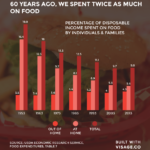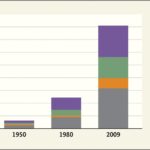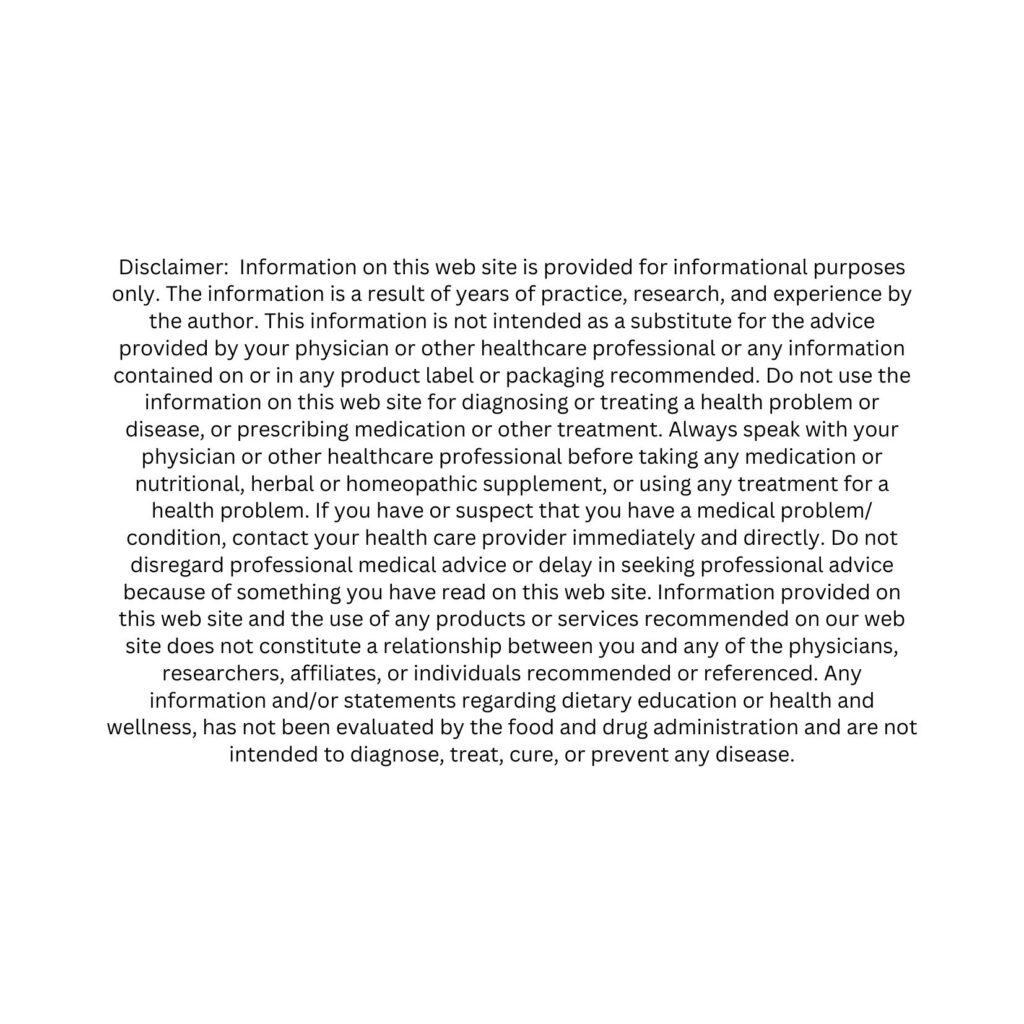The Real Cost of Cheap Food
Growing up in the 50’s and 60’s afforded us the opportunity to eat food that was not processed. For the most part, it was free of most chemicals, pesticides, herbicides and genetic modification. Most food was purchased locally.
We weren’t at the doctor’s office unless we had something major going on and those events were not commonplace. Allergies were not common and in fact, peanut and gluten allergies were unheard of. If a neighborhood kid got the measles or mumps or chicken pocks, we had parties. No sense suffering with these viruses alone. Everyone got them at the same time and then it was over AND we were inoculated against future outbreaks all at the same time. It was a win win for everyone. We spent more on our food back then and we also spent less on medical issues and insurance. Overall, we were pretty healthy.
As time went on, food got cheaper and cheaper and we have gotten sicker and sicker. Is anyone paying attention? I can tell you as a retired health coach, I am and so is Don, my beloved husband and partner in this journey. It is all about education. Let’s dig a little deeper so I can explain what the real cost of cheap food is. Let’s take a look at where we are health wise and evaluate the effectiveness of our food intake against our overall health.
While these statistics are a few years old, the story they tell is the same and it is getting worse. 70 years ago, we spent twice as much on food. Using the latest data from the USDA’s long-time tracking of food expenditures, the information has been charted going back just over six decades. The trend is obvious. Out of our total disposable income, Americans are spending a much smaller share on food today.
The data is split into two categories: food consumed ‘away from home’ & ‘at home’. Each gives us insights into how times have changed. While food prices as a whole have dropped, the country is now eating out far more often (with the most notable rise during the ‘70s fast-food boom). Even still, eating out is cheaper today than it was in the past.
Just the opposite is true for health care expenses & insurance. The seven decades since 1950 have shown an extraordinary increase in health care expenditures. The U.S. health care’s share of the GDP quadrupled from 4.6% in 1950 to more than 17% in 2009; in most peer countries, the share is 9 to 11%.
In one report I found, the United States spent the most on health care per person — $9,237 – according to two new papers published in the journal The Lancet. Somalia spent the least – just $33 per person. The data covering 184 countries was collected and analyzed by the Global Burden of Disease Health Financing Collaborator Network, a network of investigators from around the world with expertise in various aspects of health care. And the numbers keep rising. Look at the chart that I found showing data for 2017.
As expected, wealthy countries spend more on healthcare than do poor countries. Overall, where does the money come from? Low-income countries spend the least on health, & the sources of that little bit of funding are from international donors & people paying out of pocket. In middle-income countries, people still pay out of pocket, but the government is paying for some health care. In high-income countries, the money comes mostly from government and private insurance.
When paying out of pocket, the poorest people don’t get treatment — or they’ll have treatment only to be thrown into poverty because of medical costs. That’s mostly a problem for poor countries, though the U.S. stands out among high-income countries as having catastrophic medical expenditures that put people into poverty.
You’d think that with all of the increased spending & medical breakthroughs that take place, health outcomes would generally improve, but that isn’t the case. Just compare the U.S. and the U.K. Both are high-income, highly developed countries. The U.K. spends less per person ($3,749) on health care than the U.S. ($9,237). Despite its high spending, the U.S. does not have the best health outcomes. Life expectancy is 79.1 years in the U.S. and 80.9 years in the U.K. AND while the U.S. spends more on health care than any country in the world, it ranks 12th in life expectancy among the 12 wealthiest industrialized countries. This is last place! This is according to the Kaiser Family Foundation, a non-profit organization focusing on health issues. Here is the link if you want to read more….. What Country Spends The Most (And Least) On Health Care Per Person? OR How does health spending in the U.S. compare to other countries?
Why am I telling you all of this? Because I realized, through my journey, that the more we consume poor quality, cheap food, the sicker we get in spite of the fact that we spend so much on trying to stay healthy or fight disease. Don & I felt that it was time to do something. Our lives, the lives of our family members and the future of our country and our planet are at stake.
We opened Soups On Main, in Hackettstown, NJ, as the culmination of our desire to help our community to thrive. In addition to trying to educate the public, we wanted to offer a solution to the epidemic of poor-quality food. Families are strapped for time now more than ever. Juggling parenthood responsibilities while providing food and shelter for their families is no easy feat. The stress of covering added expenses for insurance, health care, automobiles, education, fun time activities, etc., leaves little time for working parents to spend in the kitchen.
Cooking takes time. Shopping for food and cleaning up afterwards is also time consuming. Unfortunately for many, these tasks which are so vital to our health, have been left to the demise of the “big food industry”. Unfortunately, the “big food industry” is also married to the “big pharma industry” and they are in bed with the “big insurance industry”. And guess what? There is no money in health. The healthier you are, the less money “big companies” make. Big bucks and big profits are made from the processed food, pharmaceutical and insurance business sector. Because these three avenues of commerce are jointly owned by the few at the very top, they can afford to rob Peter to pay Paul. They can afford to make cheap garbage food at the expense of your health and our environment because they will make up the lost food profits on the medical side of the equation. For them it’s a win win situation.
Instead of pointing fingers and verbally complaining about the challenges we face today, Don and I decided to do something about it. We wanted to offer people an alternative to the typical “fast food” of today. But we too face challenges. One challenge is to change the “cheap food” mentality which is so common from people living in the United States today. People are used to large portions of food dished out at cheap prices. They are used to being able to buy processed food, ready to go, for pennies on the dollar. Big food manufacturers want you to keep coming back for more. They’ve engineered the food to be highly addictive, filled with salt, sugar and unhealthy fats.
If people would stop to consider what it took to get food to their dinner plate, they might realize it is humanly impossible to provide nutritious food at cheap prices. People might start to realize what the true cost of that cheap food really is from the standpoint of their health. And how about the health & welfare of the people that are helping to bring food to our table? How about the health and quality of life of the animals being raised to feed us? How about the cost to our planet from the chemicals and poisons that are incorporated into the growing of cheap crops? And more than that is the cost that we really pay when we start to experience ill health because of the lack of nutrition and the chemicals present in these cheap foods? Don’t believe me. Here are some links to documentaries and films that are bringing these abuses and atrocities to light:
- E-Motion – The Physical Symptoms of Disease
- Seeds of Death
- The Truth About Milk
- Genetic Roulette – This movie was released in August of 2012 and covers the studies that are surfacing about genetically modified foods and organisms.
- Dr. Burzynski: Cancer, Cure, Cover Up – At least watch the first 3 ½ minutes of this. This doctor is curing cancer and being sued because he is curing cancer and talking about it. Cancer is big business in the USA.
- The Cancer Report
- Is Sugar Toxic?
- Sugar Coated
- The Case Against Sugar
- So Glyphosate isn’t used for commercial farming – really?
- Desiccation & Pre-Harvest Burndown with Glyphosate or other herbicides and chemicals that are harmful to human health. Now you know why we are getting sicker & sicker!
This is just a small sampling of the information that is available that will tell us the truth about what is happening to our health, our food, our environment, our planet.
Questions? Feel free to email me at do********@********il.com. Together we can and will make a difference in the lives of those living in our community and surrounding locales.


